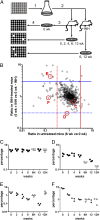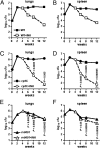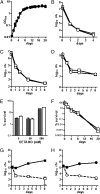Mycobacterium tuberculosis persistence mutants identified by screening in isoniazid-treated mice
- PMID: 20566858
- PMCID: PMC2901468
- DOI: 10.1073/pnas.1003219107
Mycobacterium tuberculosis persistence mutants identified by screening in isoniazid-treated mice
Abstract
Tuberculosis (TB) is notoriously difficult to cure, requiring administration of multiple antibiotics for 6 mo or longer. Conventional anti-TB drugs inhibit biosynthetic processes involved in cell growth and division, such as DNA replication, RNA transcription, protein translation, and cell wall biogenesis. Although highly effective against bacteria cultured in vitro under optimal growth conditions, these antibiotics are less effective against bacteria grown in vivo in the tissues of a mammalian host. The factors that contribute to the antibiotic tolerance of bacteria grown in vivo are unknown, although altered metabolism and sluggish growth are hypothesized to play a role. To address this question, we identified mutations in Mycobacterium tuberculosis that impaired or enhanced persistence in mice treated with isoniazid (INH), a front-line anti-TB drug. Disruption of cydC, encoding a putative ATP-binding cassette transporter subunit, accelerated bacterial clearance in INH-treated mice without affecting growth or survival in untreated mice. Conversely, transposon insertions within the rv0096-rv0101 gene cluster attenuated bacterial growth and survival in untreated mice but paradoxically prevented INH-mediated killing of bacteria in treated mice. These contrasting phenotypes were dependent on the interaction of the bacteria with the tissue environment because both mutants responded normally to INH when grown in macrophages ex vivo or in axenic cultures in vitro. Our findings have important implications because persistence-impairing mutations would be missed by conventional genetic screens to identify candidate drug targets. Conversely, persistence-enhancing mutations would be missed by standard diagnostic methods, which are performed on bacteria grown in vitro, to detect drug resistance.
Conflict of interest statement
The authors declare no conflict of interest.
Figures




Similar articles
-
Analysis of interactions of clinical mutants of catalase-peroxidase (KatG) responsible for isoniazid resistance in Mycobacterium tuberculosis with derivatives of isoniazid.J Glob Antimicrob Resist. 2017 Dec;11:57-67. doi: 10.1016/j.jgar.2017.06.014. Epub 2017 Jul 23. J Glob Antimicrob Resist. 2017. PMID: 28743650
-
Validation of Novel Mycobacterium tuberculosis Isoniazid Resistance Mutations Not Detectable by Common Molecular Tests.Antimicrob Agents Chemother. 2018 Sep 24;62(10):e00974-18. doi: 10.1128/AAC.00974-18. Print 2018 Oct. Antimicrob Agents Chemother. 2018. PMID: 30082293 Free PMC article.
-
Comparative study of enzymatic activities of new KatG mutants from low- and high-level isoniazid-resistant clinical isolates of Mycobacterium tuberculosis.Tuberculosis (Edinb). 2016 Sep;100:15-24. doi: 10.1016/j.tube.2016.06.002. Epub 2016 Jun 16. Tuberculosis (Edinb). 2016. PMID: 27553406
-
Overview on mechanisms of isoniazid action and resistance in Mycobacterium tuberculosis.Infect Genet Evol. 2016 Nov;45:474-492. doi: 10.1016/j.meegid.2016.09.004. Epub 2016 Sep 6. Infect Genet Evol. 2016. PMID: 27612406 Review.
-
Isoniazid Resistance and Dosage as Treatment for Patients with Tuberculosis.Curr Drug Metab. 2017;18(11):1030-1039. doi: 10.2174/1389200218666171031121905. Curr Drug Metab. 2017. PMID: 29086682 Review.
Cited by
-
Mycobacterium tuberculosis Adaptation in Response to Isoniazid Treatment in a Multi-Stress System That Mimics the Host Environment.Antibiotics (Basel). 2023 May 5;12(5):852. doi: 10.3390/antibiotics12050852. Antibiotics (Basel). 2023. PMID: 37237755 Free PMC article.
-
Gene Regulatory Mechanism of Mycobacterium Tuberculosis during Dormancy.Curr Issues Mol Biol. 2024 Jun 11;46(6):5825-5844. doi: 10.3390/cimb46060348. Curr Issues Mol Biol. 2024. PMID: 38921019 Free PMC article. Review.
-
Targeting persisters for tuberculosis control.Antimicrob Agents Chemother. 2012 May;56(5):2223-30. doi: 10.1128/AAC.06288-11. Epub 2012 Mar 5. Antimicrob Agents Chemother. 2012. PMID: 22391538 Free PMC article. Review.
-
Microbial persistence and the road to drug resistance.Cell Host Microbe. 2013 Jun 12;13(6):632-42. doi: 10.1016/j.chom.2013.05.009. Cell Host Microbe. 2013. PMID: 23768488 Free PMC article. Review.
-
The heterogeneous evolution of multidrug-resistant Mycobacterium tuberculosis.Trends Genet. 2013 Mar;29(3):160-9. doi: 10.1016/j.tig.2012.11.005. Epub 2012 Dec 13. Trends Genet. 2013. PMID: 23245857 Free PMC article. Review.
References
-
- Ginsberg AM, Spigelman M. Challenges in tuberculosis drug research and development. Nat Med. 2007;13:290–294. - PubMed
-
- van den Boogaard J, et al. Community vs. facility-based directly observed treatment for tuberculosis in Tanzania's Kilimanjaro Region. Int J Tuberc Lung Dis. 2009;13:1524–1529. - PubMed
-
- McKinney JD. In vivo veritas: The search for TB drug targets goes live. Nat Med. 2000;6:1330–1333. - PubMed
Publication types
MeSH terms
Substances
Grants and funding
LinkOut - more resources
Full Text Sources
Other Literature Sources
Medical
Molecular Biology Databases

